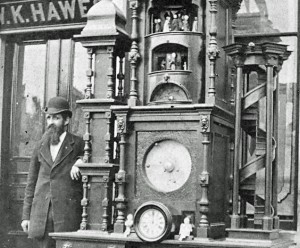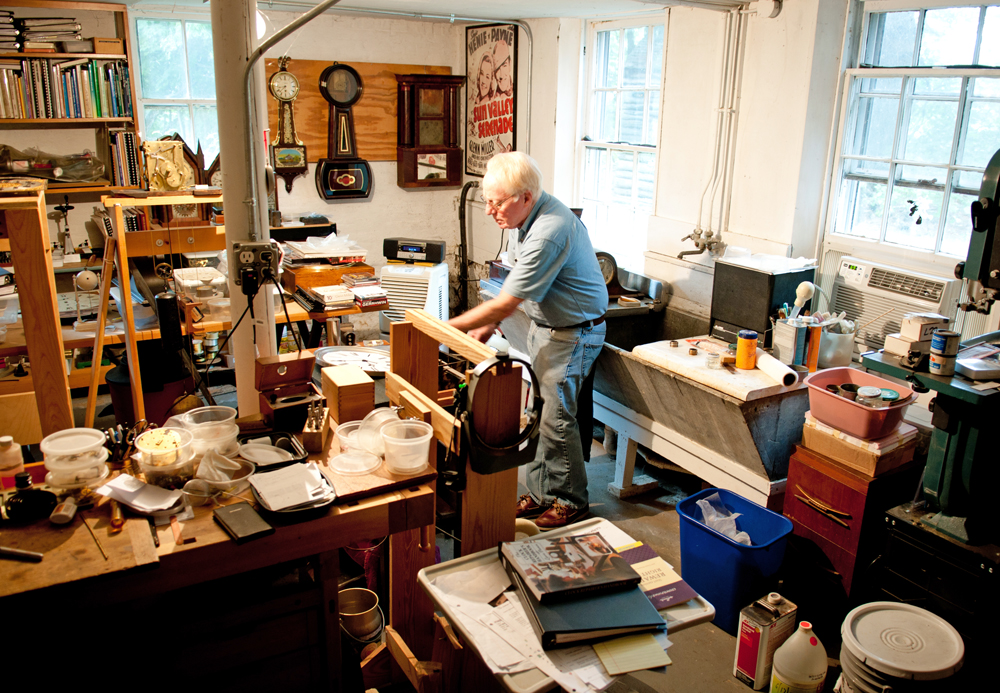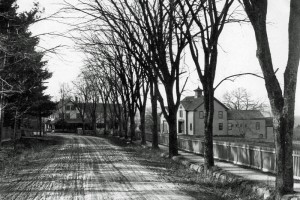True Tales from Canton’s Past: Time after Time
By George T. ComeauThis story was written nine years ago. And as time passed, my dear friend embraced aging with an ever-burgeoning family. Grandchildren and great-grandchildren blossomed and this kind man smiled. There is a poignancy in growing old and wise. A day before I learned of Larry’s passing last week, I dreamed of the two of us on a ladder in the local library as we changed out the movement of a clock. The next day, news of Larry’s death reached my email inbox. I was struck by this spiritual moment and our intersection in life.
Larry had a stroke and he was hanging a clock in his living room when he was stricken. The beauty of the passing is that he was doing what he loved most and following his passion until the end of his life. Betty and Larry had been married for 60 years. It was a full and vivid life and one that was very connected to Canton.
I went back to read this story, and it’s only fitting to share this once again.
***
December 15, 1968, Larry and Betty Chelmow had just turned the key on their new home in Canton. Proud owners of an antique house on Chapman Street, they had finished their walk-through and were heading back to Randolph, three children in tow, to pack up and move to Canton.
Their house sits just north of the Chapman Street Bridge, a Federal-style house with beautiful Italianate details. As they left their new home, there were plenty of dreams for this young couple. The house in Canton was perfect — after all, the realty agent said so! Their new home boasted plenty of room to raise a family, a gracious side yard, and an antique barn set on one of Canton’s oldest streets.
Larry knows the exact time they turned the key on that door as they left their new house. Only five minutes later, at 5:15 p.m., a New Haven Railroad freight train derailed right behind the Chelmows’ home. Larry and Betty did not find out until the next morning when they pulled into their driveway only to find hundreds of gawking spectators watching the progress on the rail bed below. “There were all these people in our yard and on the bridge and smoke was rising up over our new home,” said Larry. “It was a real wreck.”
Inside the Chelmow home is a front-page aerial photograph, framed and under glass, that shows the mayhem that day 46 years ago. The crash led to the longest shutdown of the Northeast Corridor line in the history of the railroad. The line was closed for six days, 11 hours and 28 minutes — an eternity for a railroad. And the loss to the company was tremendous — 77 cars were involved in the accident and 40 cars derailed. In fact, 30 of the 40 cars were literally wedged in the 35-foot cut right behind the Chelmows’ new property. Two weeks later the New Haven Railroad ceased to exist, becoming part of the Penn Central Railroad after almost eight years in bankruptcy proceedings.
The Chelmows’ introduction to Canton was indeed historic, and yet their house has always figured in the history of our town. One of the best surviving early farmhouses in the town, it was built in May 1826 for Marcus Clark, a farmer, on the site of an earlier 18th century house that had been owned by Henry Morse.
It was most likely a modest house when Clark owned it, and during the construction of the Canton Viaduct, in 1834, it was rented to the then 23-year-old Oliver Smith Chapman. The access to the new railroad was important to Chapman; he was a newly established railroad construction engineer. Building railroads in America was a young venture, and the new Boston & Providence rail line was one of the first new lines in the country.
O.S. Chapman, as he was known, was born in Belchertown and was a wheelwright, as was his father before him. At a young age Chapman had established a sawmill and became a relatively successful man. Chapman’s first work on a railroad may well have been in Canton, as he was involved in assisting with the work at the Viaduct. He may well have supervised the railroad cut behind the Chelmows’ house — his specialty was excavating “difficult passages of solid rock.” He, along with his cousin, William Smith Otis, developed the steam shovel. Invented for work on the Western Railroad in 1837, Chapman and Otis became quite successful as a result of their machine. By 1858, Chapman had worked on building the Vermont Central Railroad and had a contract to fill in the Back Bay of Boston.
Money seemed to flow from everything Chapman did, and as he became wealthy, he became influential. Named a director of the Union Pacific and the Canada Southern railroads, Chapman began buying large tracts of land in Michigan, Wisconsin and Iowa. In 1858, he moved back to Canton and purchased the small house that he had rented more than two decades earlier. The Clark House became the Chapman House and major renovations ensued. A mid-19th century home of a man with means allowed the house to become more Italianate in design. To the east a new wing emerged, new chimneys and fireplaces in the bedrooms were all part of the “modern” comforts of life in the 1850s.
The property that Larry and Betty Chelmow purchased in 1966 was essentially two houses — the center core built in 1826 surrounded by the 1858 renovations. Subsequent owners left their mark on the house as well, with a 1919 upgrade adding Georgian Revival fireplace mantels and improvements to the “auto barn.”
The one thing that is most striking (pun intended) about the Chelmow house are the clocks. Well over 100 clocks are spread throughout the house. These days most people rely upon their microwave or iPhones for telling time. But actual clocks that tick, have a pendulum, strike the hours, can be wound — are vestiges of the past. When you buy a clock today it has a battery, but at Larry Chelmow’s house each and every clock has to be wound by hand.
“I was always very fond of hardware, and was collecting guns in the mid 1960s,” explains Chelmow. “One day we stopped at a home in Randolph owned by Charlie Cyr; he had a sign on his lawn that advertised clocks.” Chelmow had stumbled upon a new hobby — that of collecting and repairing antique clocks. “We didn’t have a pot to pee in,” Chelmow wryly continues, “so I traded the guns for clocks, and with that trade Charlie took me to the cleaners — the guns were far more valuable than the small pile of clocks I received in trade.” The friendship between the two men grew and Chelmow learned plenty about clock making in those early days.
Today, in the basement of the house on Chapman Street, Larry Chelmow is working in a place where time stops — literally. The small, whitewashed room is cool in the summer and a single antique-style filament bulb illuminates his work area. Everything is tidy; hundreds of parts are filed in old library card-catalog drawers. Nearby a woodstove is ready for the winter chill. Each day that Chelmow spends down in his shop represents the preservation of time. This is the perfect house in which to repair clocks, and they seem to fit in perfectly throughout. Clocks from the early 19th century sit next to modern tall case instruments all lovingly cared for. Museums send their clocks to Chelmow, and his precision is renowned. Chelmow is a trustee of the Charles River Museum of Industry and Innovation and is frequently bidding on eBay for all things horologic — um, clock related.
Today, Chelmow is working on an old clock that hangs in the Canton Historical Society. Attributed to William K. Hawes, the “Hawes Clock” has hung at the society for many years. For a long time it was thought that Hawes himself built the clock, but today we learn this was not the case.

Hawes standing outside his shop on Washington Street displaying a rare Grand Strasburg Clock, an oddity that he kept in his store (Courtesy of the author)
The sign on the store on Washington Street read “William K. Hawes Watchmaker and Jeweler,” specializing in “Watches, Silverware, and Optical Goods.” Inside the 800-square-foot store Hawes sold watches and clocks. He was described as an “upright and honorable man,” which was essential to the trade in the late 19th century.
It is likely that the clock that Chelmow is working on today was Hawes’ regulator clock. The regulator was the tool by which a clockmaker or merchant would set all other clocks and watches by to ensure accuracy over time. In this case the timepiece being repaired today was built most likely in Switzerland between 1870 and 1890. This clock is very well constructed and very precise and known for keeping excellent time. Hawes lived on Chapman Street, coincidently a few doors down from the very place his clock is being repaired today.
The “Hawes Clock” sits in a simple pine case and a small stepstool is required for weekly windings. One day, Ed Bolster, the then society president, asked Jim Roache to wind the clock. Roache turned the winder and the heavy weight broke loose and fell through the bottom of the clock. And that is when time stopped — about 20 years ago. Life starts again for this clock in the hands of master clocksmith Chelmow.
In the tiny workshop Chelmow leans against a soapstone sink, Glen Miller plays softly in the background as he contemplates my question. “No, I have never built my own clock,” he says, “but it is on my bucket list — and it will be a simple, time-only clock in a shaker-style case. My dream clock is quite simple.”
Chelmow lifts the mechanism of the Hawes Clock and observes that in fact the porcelain dial is in superb condition and the clock most likely only needs a cleaning. When completed in a few weeks the Hawes Clock will be the most precise timekeeping instrument in Canton — at least as far as mechanical clocks go.
Epilogue: Larry Chelmow passed away on Wednesday, September 29, and is buried at the Canton Corner Cemetery. Canton has lost a wonderful man.
Short URL: https://www.thecantoncitizen.com/?p=15152












